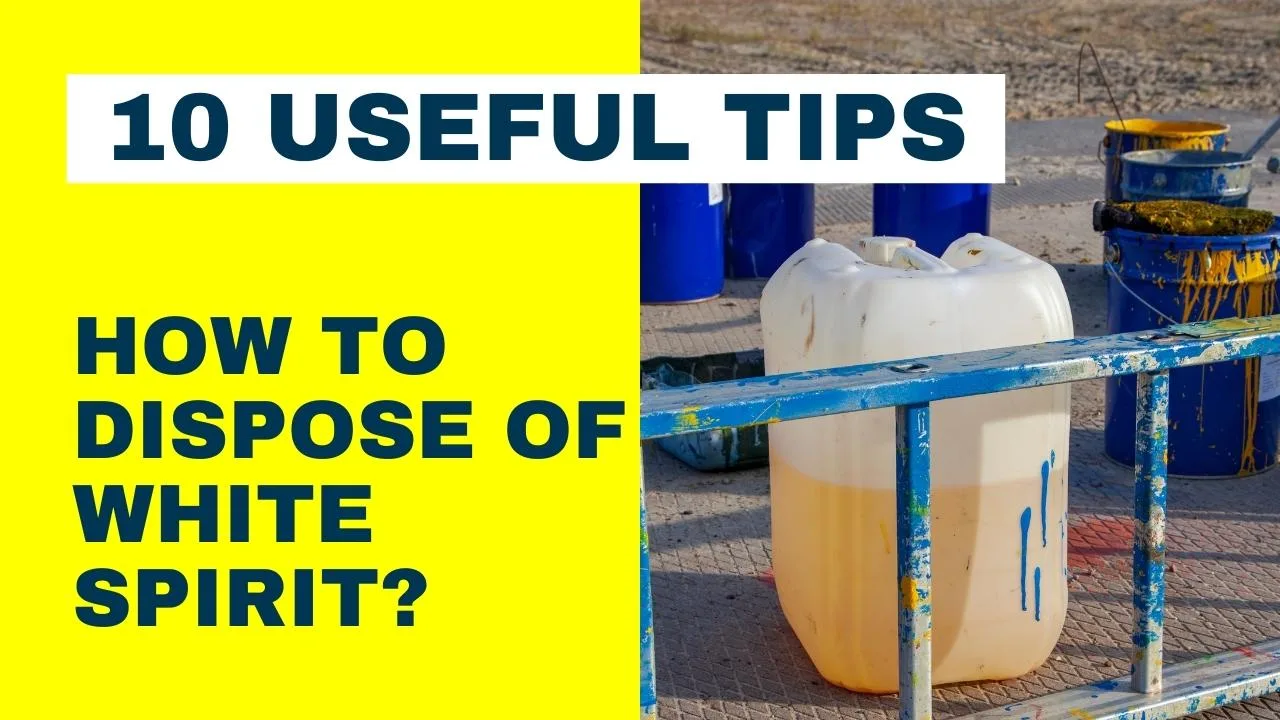How to Dispose of White Spirit?

White spirit is a versatile solvent widely used for cleaning, degreasing, and thinning paint. However, proper disposal of white spirit is crucial to prevent harm to both the environment and human health.
In this comprehensive guide, we will delve into responsible disposal methods tailored to diverse audiences, ranging from homeowners and DIY enthusiasts to industrial facilities and local authorities.
Table of Contents
What Are White Spirits? Properties and Uses
White spirit, also known as mineral spirits or paint thinner, is a petroleum-derived solvent. It’s prized for its effectiveness in dissolving greases, oils, and paints, making it a staple in various industries and households. However, its chemical nature demands careful handling and disposal.
White spirits are a type of solvent that is commonly used in paint thinners, nail polish removers, and other household cleaning products.
If you have any products that contain white spirits, it’s important to know how to properly dispose of them so that they don’t cause any harm to the environment.
Here Are A Few Disposal Do’s And Don’ts To Keep In Mind:
Do:
-Dispose of white spirits in accordance with your local laws and regulations.
-Put them in a sealed container and label it accordingly.
-Avoid pouring them down the drain or into bodies of water.
-Contact your local recycling center if you’re unsure about how to recycle white spirits.
Don’t:
-Pour them down the drain or into bodies of water.
-Leave them sitting out in an open container.
Disposal Options for Different Audiences:
- Homeowners and DIY Enthusiasts
- Builders, Contractors, and Landscapers
- Industrial Facilities and Businesses
- Local Authorities and Government Departments
- Environmentalists and Facility Managers
Responsible Disposal Methods:
1. Evaporation
In specific cases, evaporation can be a suitable method for white spirit disposal. However, caution is required, as the process should occur in a well-ventilated area and should not release harmful fumes into the atmosphere.
2. Disposal at Household Hazardous Waste Collection Sites
For safe disposal, locate household hazardous waste collection sites in your area. These sites are equipped to handle hazardous materials like white spirit, ensuring proper containment and disposal methods.
3. Recycling Programs
Recycling white spirit is a sustainable option. Some facilities are equipped to reclaim and repurpose used white spirit. Explore recycling options in your locality to contribute to environmental preservation.
4. Professional Hazardous Waste Disposal Services
For businesses and industries generating substantial quantities of white spirit waste, professional hazardous waste disposal services are recommended. These authorized services have the expertise to handle and dispose of hazardous waste in compliance with regulations.
How to Dispose of White Spirit? 10 Useful Tips – Steps to Safe White Spirit Disposal
Ensure you carefully read the labels of white spirit containers for specific disposal instructions. Transfer white spirit to suitable containers for disposal, ensuring they are tightly sealed to prevent leakage. During the disposal process, protect yourself by wearing appropriate protective gear, including gloves and safety goggles. Document disposal activities for compliance with regulations.
Proper disposal of white spirit requires careful attention to detail to ensure the safety of both individuals and the environment. Follow these steps to dispose of white spirit responsibly:
1. Read Labels and Instructions
- Carefully read the labels and instructions on the white spirit container. Manufacturers often provide specific guidance on safe disposal methods. Following these instructions is essential to prevent potential hazards.
2. Transfer to Suitable Containers
- Choose a suitable container for transferring the white spirit. Use containers made of materials that are compatible with white spirit, such as glass or metal. Ensure the container is clean and free from any residues of other substances.
3. Seal the Containers Tightly
- After transferring the white spirit, seal the containers tightly to prevent leakage. Leakage can lead to contamination of the surrounding environment, posing risks to human health and ecosystems.
4. Protective Gear
- Before handling white spirit, wear appropriate protective gear, including gloves, safety goggles, and a mask. These measures help minimize the risk of skin contact, inhalation of fumes, and eye irritation.
5. Disposal at Collection Sites
- For small quantities of white spirit, consider disposing of it at household hazardous waste collection sites. These facilities are equipped to handle hazardous materials and ensure their proper containment and disposal.
6. Recycling Opportunities
- Research recycling programs in your area that accept white spirit. Recycling helps prevent the release of harmful chemicals into the environment and conserves valuable resources.
7. Professional Disposal Services
- If you’re dealing with larger quantities of white spirit, consider hiring professional hazardous waste disposal services. These authorized experts have the expertise and equipment to manage and dispose of hazardous waste safely and in compliance with regulations.
8. Document Disposal Activities
- Keep a record of your disposal activities, including dates, quantities, and methods used. Documentation is essential for compliance with regulations and audits.
9. Do Not Pour Down Drains
- Never pour white spirit down drains, sinks, or toilets. White spirit can contaminate water sources and harm aquatic life.
10. Consult Local Regulations
- Be aware of local, regional, and national regulations regarding hazardous waste disposal. Compliance with these regulations is crucial to avoid legal repercussions and protect the environment.
By following these steps, you can ensure that white spirit is disposed of safely and responsibly. Remember, every action counts in safeguarding our environment and maintaining a healthier world for ourselves and future generations.
Raising Awareness and Promoting Change
Educating communities about proper white spirit disposal is paramount. By sharing information and advocating for stricter regulations, we can collectively reduce the environmental impact. Collaboration between businesses, organizations, and authorities can drive positive change.
Conclusion
And that’s the complete guide on how to properly dispose of white spirits.
Disposing of white spirit is a collective effort involving everyone, from individuals to industries. Following the recommended disposal steps from this guide helps minimize the ecological effects of white spirit waste.
Whether you’re a homeowner, contractor, or official, responsible disposal fosters a cleaner, safer environment. Adhering to these guidelines prevents environmental harm and ensures proper waste management.
FAQs
Can You Reuse White Spirit?
Yes, white spirit can be reused if it is properly filtered and stored.






